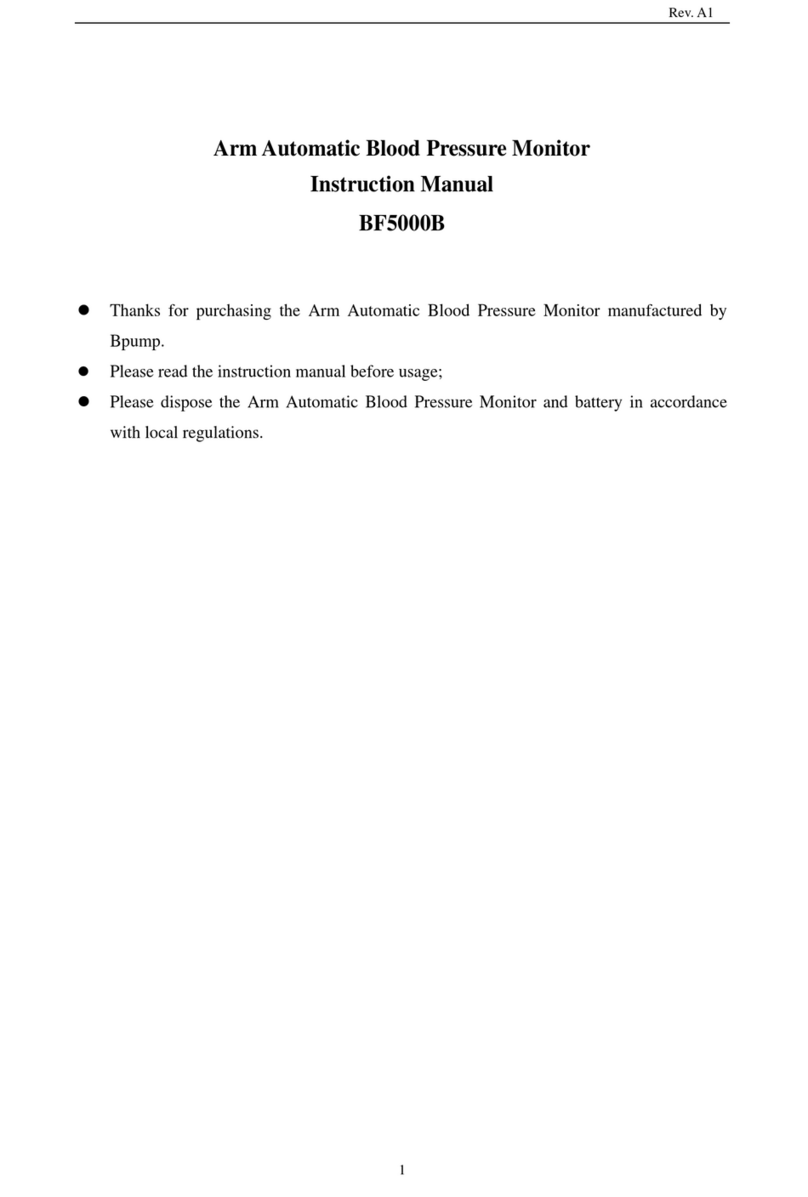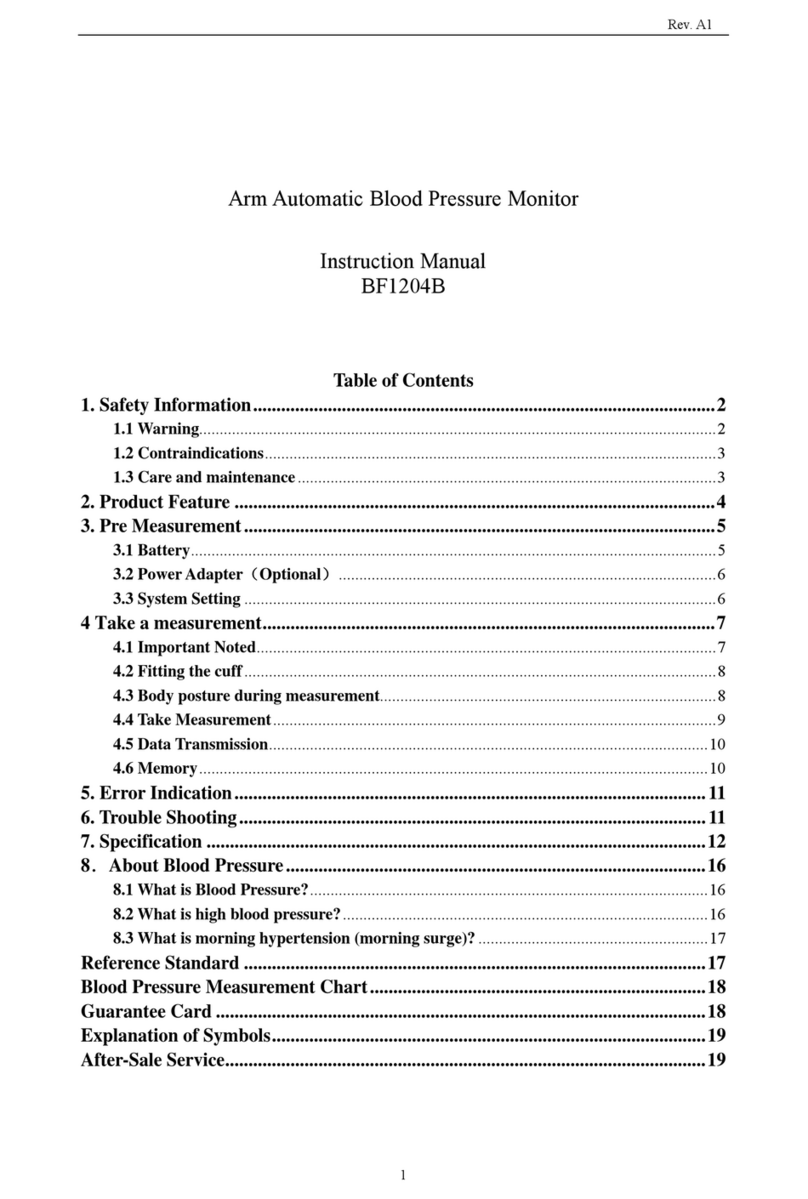SHENZHEN PUMP MEDICAL SYSTEM BF5010B User manual

2017/08/16 Rev. A1
1
ArmAutomatic Blood Pressure Monitor
Instruction Manual
BF5010B
Thanks for purchasing the Arm Automatic Blood Pressure Monitor manufactured by
Bpump.
Please read the instruction manual before usage;
Please dispose the Arm Automatic Blood Pressure Monitor and battery in accordance
with local regulations.

2017/08/16 Rev. A1
2
Table of Contents
1. Safety Information...................................................................................................3
1.1. Warning.............................................................................................................................3
1.2. Contraindications.............................................................................................................4
1.3. Care and maintenance.....................................................................................................4
2. Product Feature .......................................................................................................5
3. Power source.............................................................................................................6
3.1 Battery................................................................................................................................6
3.2 PowerAdapter(Optional)............................................................................................7
4. Clock mode...............................................................................................................8
5. First touch mode ......................................................................................................8
6. Standby mode...........................................................................................................8
7. System Setting..........................................................................................................9
7.1 User conversion...................................................................................................................9
7.2. Setting................................................................................................................................9
8. Take a measurement..............................................................................................10
8.1. Important Noted.............................................................................................................10
8.2. Fitting the cuff................................................................................................................11
8.3. Body posture during measurement...............................................................................11
8.4. Take Measurement.........................................................................................................11
8.5. Mean value......................................................................................................................13
8.6. Memory...........................................................................................................................14
9. Data transmission ..................................................................................................15
10. Power off...............................................................................................................15
11. Error Indication ...................................................................................................15
12. Trouble Shooting..................................................................................................16
13. Specification .........................................................................................................16
15. About Blood Pressure..........................................................................................17
15.1. What is Blood Pressure?..............................................................................................17
15.2. What is high blood pressure?......................................................................................17
15.3. What is morning hypertension (morning surge)?.....................................................18
Reference Standard....................................................................................................18
FCC Statement...........................................................................................................19
Blood Pressure Measurement Chart........................................................................19
Guarantee Card .........................................................................................................19
Explanation of Symbols.............................................................................................20
After-Sale Service.......................................................................................................21

2017/08/16 Rev. A1
3
1. Safety Information
1.1. Warning
1) Self diagnosis and treatment which use measured results may be dangerous. Follow the
instructions of your physician or licensed healthcare provider.
2) If cuff inflation doesn’t stop, remove the cuff or power off the unit, otherwise, it may
result in a hazard condition.
3) Only take measurement with the manufacturer supplied cuff, or else it will lead to
inaccurate results.
4) Do not use the blood pressure monitor when you are close proximity to strong static
electricity or electromagnetic fields, and avoid using the mobile during measurement.
5) Do not use in combination with a hyperbaric oxygen therapy device, or in an
environment where combustible gas may be generated.
6) Do not use in combination with other monitoring device at the same limb, because the
pressurization of the CUFF can temporarily cause loss of function of simultaneously
used monitoring ME EQUIPMENT on the same limb;
7) Do not install or use the unit in the following locations:
Locations subject to vibration such as ambulances and emergency helicopters.
-A location where there is gas or flame.
-A location where there is water or steam.
-A location where chemicals are stored.
-A location where the unit may easily fall.
8) Please follow the environment conditions specified in this manual (Storage and transport
environment: Temperature:-25 ℃~+70 ℃, Humidity:10% ~95%; Operating
environment: Temperature:+5℃~+40℃, Humidity:15%~93%), otherwise, the device
may not be able to achieve the claimed performance.
9) Do not kink the connection tube, or it may cause blood flow interference and result in
harmful injury to the PATIENT due to continuous CUFF pressure;
10) Do not use Luer lock. If Luer lock connectors are used in the construction of tubing,
there is a possibility that they might be inadvertently connected to intravascular fluid
systems, allowing air to be pumped into a blood vessel.
11) This product is suitable for use to self- monitoring of blood pressure in home or used by
the licensed healthcare personnel in hospital.
12) Blood pressure measurements determined with the device are equivalent to those
obtained by a trained observer using the cuff/stethoscope auscultatory method, within
the limit prescribed by the American National Standard, Manual, electronic or
automated sphygmomanometers.
13) Keep out of reach of infants, small children, and compromised people who cannot
express their consent. Playing the air tube may result in suffocate children, and Children
may swallow small parts and lead to suffocation.
14) Children must be supervised to ensure that they are not play with the device.
15) Use only manufacturer authorized parts and accessories. Parts and accessories not
approved for use with the device may damage the unit.

2017/08/16 Rev. A1
4
16) Adapter is considered as a part of me equipment during powered by adapter
17) Be careful not to rest your arm on the air tube. This will restrict the flow of air to the
cuff.
18) Do not measurement too frequent, or else it may result in bruising where the cuff is
applied.
19) Do not apply the cuff over a wound or inflamed area.
20) Do not apply the cuff on the same limb where intravascular access or therapy or an
arterio-venous (A-V) shunt is present, because of temporary interference to blood flow
and could result in injury to the patient.
21) Do not apply the cuff on the arm on the side where a mastectomy has done, because of
temporary interference to blood flow and could result in injury to the patient.
22) The application of the cuff and its pressurization on the arm can cause temporary
interference to blood flow, but it would not result in injury to the patient.
23) Operation of the device does not result in prolonged impairment of the circulation of the
blood of the patient.
24) Direct plug is considered as disconnect device, please do not place the equipment in a
difficultly operation position.
25) When using the device, the patient is an intended operator.
26) Do not serviced or maintained while in use with the patient.
1.2. Contraindications
1) Do not use the blood pressure monitor for any other purpose except measuring the blood
pressure of human body.
2) Those who have arrhythmia, diabetes, blood circulation or apoplexy problem, please use
under the physician’s instruction.
3) Clinical testing has not been conducted on newborn infants and pregnant women. Do not
use in infants and pregnant women.
4) The common arrhythmia such as atria premature beats, premature ventricular and atrial
fibrillation will lead to inaccurate results or error.
1.3. Care and maintenance
1) The battery can’t be replaced, do not attempt to disassemble, repair or modify the unit or
cuff.
2) Avoid high temperature, moisture, dust and direct sunlight.
3) Clean the body with soft clean wet cloth, do not wipe with alcohol or other corrosive
liquids.
4) Do not wet or clean the cuff with water.
5) Clean the cuff with soft dry cloth after measurement.
6) Do not use at extremely high temperature, high humidity, or high altitude.
7) Do not drop or expose the device to heavy shock.
8) Do not use the unit near large equipment that uses a switching relay for power ON/OFF.
9) Turn off the power switch if the unit will not use for a long time.
10) The blood pressure monitor has gone through several trials of testing to ensure the
measurement accuracy. It is recommended that the performance be checked every 2 years

2017/08/16 Rev. A1
5
and after maintenance and repair.
11) Do not disassemble or modify the structure of the unit and damage the safety
performance. If you need service, please contact the manufacturer, the maintenance
should be done by authorized persons of manufacturer. Maintenance of the necessary
technical document, including the schematics, key components list and etc., will
provided by the manufacturer for maintenance personnel.
12) Care and maintenance of lithium battery:
Please keep the unit away from the fire or heat source, do not put the waste of the
unit or battery into fire.
Do not frequently run out of battery , avoid affecting the battery life.
Do not forcibly boot after battery runs out ,avoid irreversible damage to the battery.
Use the correct adapter designed for your local voltage (AC 100-240 V)
If the unit is to remain unused for an extended period(more than 7 days), please
ensure that the battery retains a certain amount of electricity , turn off the power
switch to disconnect the lithium battery.
Precaution!Please read the enclosed instruction.
2. Product Feature
Intended Use
It is intended for measuring systolic, diastolic blood pressure and pulse rate of an
adult over the counter.
Body
Fig 1
Cuff(Type BF Applied Part)
Model:BC1000
ApplicableArm Circumference:
BC1000: 22cm to 36cm (8.7in to 14.2in)
Table of contents
Other SHENZHEN PUMP MEDICAL SYSTEM Blood Pressure Monitor manuals



















